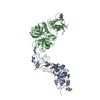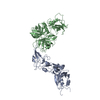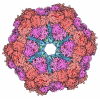+ Open data
Open data
- Basic information
Basic information
| Entry | Database: PDB / ID: 8yoy | ||||||
|---|---|---|---|---|---|---|---|
| Title | Structure of HKU1A RBD with TMPRSS2 | ||||||
 Components Components |
| ||||||
 Keywords Keywords | VIRAL PROTEIN/HYDROLASE / HKU1A / RBD / TMPRSS2 / VIRAL PROTEIN-HYDROLASE complex | ||||||
| Function / homology |  Function and homology information Function and homology informationtransmembrane protease serine 2 / protein autoprocessing / Attachment and Entry / serine-type peptidase activity / endocytosis involved in viral entry into host cell / viral translation / Induction of Cell-Cell Fusion / host cell endoplasmic reticulum-Golgi intermediate compartment membrane / Attachment and Entry / positive regulation of viral entry into host cell ...transmembrane protease serine 2 / protein autoprocessing / Attachment and Entry / serine-type peptidase activity / endocytosis involved in viral entry into host cell / viral translation / Induction of Cell-Cell Fusion / host cell endoplasmic reticulum-Golgi intermediate compartment membrane / Attachment and Entry / positive regulation of viral entry into host cell / receptor-mediated virion attachment to host cell / fusion of virus membrane with host plasma membrane / serine-type endopeptidase activity / fusion of virus membrane with host endosome membrane / viral envelope / host cell plasma membrane / virion membrane / proteolysis / extracellular exosome / extracellular region / nucleoplasm / membrane / plasma membrane Similarity search - Function | ||||||
| Biological species |  Candidatus Accumulibacter adiacens (bacteria) Candidatus Accumulibacter adiacens (bacteria) Homo sapiens (human) Homo sapiens (human) | ||||||
| Method | ELECTRON MICROSCOPY / single particle reconstruction / cryo EM / Resolution: 3.21 Å | ||||||
 Authors Authors | Gao, X. / Cui, S. / Ding, W. / Shang, K. / Zhu, H. / Zhu, K. | ||||||
| Funding support | 1items
| ||||||
 Citation Citation |  Journal: Cell Discov / Year: 2024 Journal: Cell Discov / Year: 2024Title: Structural basis for the interaction between human coronavirus HKU1 spike receptor binding domain and its receptor TMPRSS2. Authors: Xiaopan Gao / Kaixiang Zhu / Lin Wang / Kun Shang / Lei Hua / Bo Qin / Hongtao Zhu / Wei Ding / Sheng Cui /  | ||||||
| History |
|
- Structure visualization
Structure visualization
| Structure viewer | Molecule:  Molmil Molmil Jmol/JSmol Jmol/JSmol |
|---|
- Downloads & links
Downloads & links
- Download
Download
| PDBx/mmCIF format |  8yoy.cif.gz 8yoy.cif.gz | 127.2 KB | Display |  PDBx/mmCIF format PDBx/mmCIF format |
|---|---|---|---|---|
| PDB format |  pdb8yoy.ent.gz pdb8yoy.ent.gz | 94.9 KB | Display |  PDB format PDB format |
| PDBx/mmJSON format |  8yoy.json.gz 8yoy.json.gz | Tree view |  PDBx/mmJSON format PDBx/mmJSON format | |
| Others |  Other downloads Other downloads |
-Validation report
| Summary document |  8yoy_validation.pdf.gz 8yoy_validation.pdf.gz | 358.7 KB | Display |  wwPDB validaton report wwPDB validaton report |
|---|---|---|---|---|
| Full document |  8yoy_full_validation.pdf.gz 8yoy_full_validation.pdf.gz | 364 KB | Display | |
| Data in XML |  8yoy_validation.xml.gz 8yoy_validation.xml.gz | 13.8 KB | Display | |
| Data in CIF |  8yoy_validation.cif.gz 8yoy_validation.cif.gz | 20.8 KB | Display | |
| Arichive directory |  https://data.pdbj.org/pub/pdb/validation_reports/yo/8yoy https://data.pdbj.org/pub/pdb/validation_reports/yo/8yoy ftp://data.pdbj.org/pub/pdb/validation_reports/yo/8yoy ftp://data.pdbj.org/pub/pdb/validation_reports/yo/8yoy | HTTPS FTP |
-Related structure data
| Related structure data |  39460MC  8yqqC M: map data used to model this data C: citing same article ( |
|---|---|
| Similar structure data | Similarity search - Function & homology  F&H Search F&H Search |
- Links
Links
- Assembly
Assembly
| Deposited unit | 
|
|---|---|
| 1 |
|
- Components
Components
| #1: Protein | Mass: 41425.062 Da / Num. of mol.: 1 / Fragment: RBD domain Source method: isolated from a genetically manipulated source Details: Sequence reference for Candidatus Accumulibacter adiacens (2954378) is not available in UniProt at the time of biocuration. Current sequence reference is from UniProt ID Q5MQD0. Source: (gene. exp.)  Candidatus Accumulibacter adiacens (bacteria) Candidatus Accumulibacter adiacens (bacteria)Gene: S, 3 / Production host:  Baculovirus expression vector pFastBac1-HM / References: UniProt: Q5MQD0 Baculovirus expression vector pFastBac1-HM / References: UniProt: Q5MQD0 |
|---|---|
| #2: Protein | Mass: 42381.848 Da / Num. of mol.: 1 Source method: isolated from a genetically manipulated source Source: (gene. exp.)  Homo sapiens (human) / Gene: TMPRSS2, PRSS10 / Production host: Homo sapiens (human) / Gene: TMPRSS2, PRSS10 / Production host:  Baculovirus expression vector pFastBac1-HM Baculovirus expression vector pFastBac1-HMReferences: UniProt: O15393, transmembrane protease serine 2 |
| Has ligand of interest | N |
| Has protein modification | Y |
-Experimental details
-Experiment
| Experiment | Method: ELECTRON MICROSCOPY |
|---|---|
| EM experiment | Aggregation state: PARTICLE / 3D reconstruction method: single particle reconstruction |
- Sample preparation
Sample preparation
| Component | Name: HKU1A-RBD with TMPRSS2 receptor / Type: COMPLEX / Entity ID: all / Source: RECOMBINANT |
|---|---|
| Source (natural) | Organism:  Homo sapiens (human) Homo sapiens (human) |
| Source (recombinant) | Organism:  Baculovirus expression vector pFastBac1-HM Baculovirus expression vector pFastBac1-HM |
| Buffer solution | pH: 8 |
| Specimen | Embedding applied: NO / Shadowing applied: NO / Staining applied: NO / Vitrification applied: YES |
| Specimen support | Grid material: GOLD / Grid type: Quantifoil R1.2/1.3 |
| Vitrification | Cryogen name: ETHANE |
- Electron microscopy imaging
Electron microscopy imaging
| Experimental equipment |  Model: Titan Krios / Image courtesy: FEI Company |
|---|---|
| Microscopy | Model: FEI TITAN KRIOS |
| Electron gun | Electron source:  FIELD EMISSION GUN / Accelerating voltage: 300 kV / Illumination mode: FLOOD BEAM FIELD EMISSION GUN / Accelerating voltage: 300 kV / Illumination mode: FLOOD BEAM |
| Electron lens | Mode: BRIGHT FIELD / Nominal defocus max: 2500 nm / Nominal defocus min: 1800 nm / Calibrated defocus max: 2500 nm / Alignment procedure: COMA FREE |
| Specimen holder | Cryogen: NITROGEN / Specimen holder model: FEI TITAN KRIOS AUTOGRID HOLDER |
| Image recording | Electron dose: 55 e/Å2 / Film or detector model: GATAN K3 (6k x 4k) |
- Processing
Processing
| CTF correction | Type: PHASE FLIPPING AND AMPLITUDE CORRECTION | ||||||||||||||||||||||||
|---|---|---|---|---|---|---|---|---|---|---|---|---|---|---|---|---|---|---|---|---|---|---|---|---|---|
| 3D reconstruction | Resolution: 3.21 Å / Resolution method: FSC 0.143 CUT-OFF / Num. of particles: 423131 / Symmetry type: POINT | ||||||||||||||||||||||||
| Refine LS restraints |
|
 Movie
Movie Controller
Controller




 PDBj
PDBj


